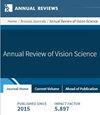Fuchs Endothelial Corneal Dystrophy: Clinical, Genetic, Pathophysiologic, and Therapeutic Aspects.
IF 5
2区 医学
Q1 NEUROSCIENCES
引用次数: 61
Abstract
Fuchs endothelial corneal dystrophy (FECD) is a bilateral corneal endothelial disorder and the most common cause of corneal transplantation worldwide. Professor Ernst Fuchs described the first 13 cases of FECD more than 100 years ago. Since then, we have seen far-reaching progress in its diagnosis and treatment. In the field of diagnostics, new technologies enable the development of more accurate classification systems and the more detailed breakdown of the genetic basis of FECD. Laboratory studies help in deciphering the molecular pathomechanisms. The development of minimally invasive surgical techniques leads to a continuous improvement of the postoperative result. This review highlights and discusses clinical, genetic, pathophysiologic, and therapeutic aspects of this common and important corneal disorder.富克斯内皮性角膜营养不良:临床、遗传、病理生理和治疗方面。
Fuchs内皮性角膜营养不良(FECD)是一种双侧角膜内皮疾病,也是世界范围内角膜移植最常见的原因。Ernst Fuchs教授描述了100多年前第一批13例FECD。从那时起,我们看到在其诊断和治疗方面取得了深远的进展。在诊断领域,新技术能够开发更准确的分类系统,并更详细地分析FECD的遗传基础。实验室研究有助于解读分子病理机制。微创手术技术的发展使术后效果不断改善。这篇综述强调并讨论了这种常见和重要的角膜疾病的临床、遗传、病理生理和治疗方面。
本文章由计算机程序翻译,如有差异,请以英文原文为准。
求助全文
约1分钟内获得全文
求助全文
来源期刊

Annual Review of Vision Science
Medicine-Ophthalmology
CiteScore
11.10
自引率
1.70%
发文量
19
期刊介绍:
The Annual Review of Vision Science reviews progress in the visual sciences, a cross-cutting set of disciplines which intersect psychology, neuroscience, computer science, cell biology and genetics, and clinical medicine. The journal covers a broad range of topics and techniques, including optics, retina, central visual processing, visual perception, eye movements, visual development, vision models, computer vision, and the mechanisms of visual disease, dysfunction, and sight restoration. The study of vision is central to progress in many areas of science, and this new journal will explore and expose the connections that link it to biology, behavior, computation, engineering, and medicine.
 求助内容:
求助内容: 应助结果提醒方式:
应助结果提醒方式:


